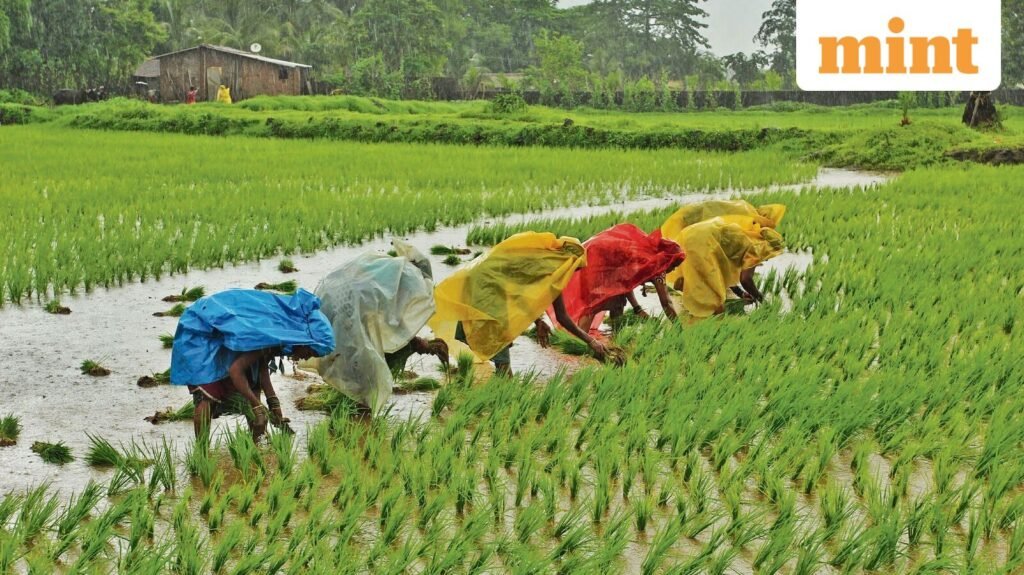According to a report by the World Trade Organization (WTO), the policy shift contributed to a 29% fall in global rice prices in 2025, and helped cool food inflation—particularly in African and Asian countries such as Senegal, Benin and Bangladesh, which depend heavily on Indian rice.
The WTO report, released on 7 November, cited the International Grains Council’s Grains and Oilseeds Index (GOI) to note that global food prices overall—including rice and other foods—fell 2% year-on-year in 2025, and 39% from their 2022 peak, led by easing cereal prices following India’s reversal.
Experts Mint spoke with corroborated WTO’s findings, saying the timing of India’s move was crucial, as global grain prices were under pressure from the lingering effects of the Ukraine conflict and high energy costs.
Between 2022 and 2023, New Delhi had imposed several export curbs to rein in inflation—from 20% duties on milled, unmilled and parboiled rice to bans on broken and non-basmati white rice, along with a minimum export price for basmati.
Between September 2024 and March 2025, these measures were gradually eased and then completely lifted.
Following the rollback, India’s rice exports to 172 countries surged to 20.1 million tonnes valued at about $12.95 billion in FY25, according to data from the commerce ministry. In FY24, that number was 16.35 million tonnes.
The scale of the policy’s impact underscores India’s weight in global rice supply. According to Vijay Setia, director at Chaman Lal Setia Exports Ltd, and former president of All India Rice Exporters’ Association (Airea), New Delhi accounts for nearly 45% of the world’s rice exports, and any policy shift here directly influences global food prices.
“Easing export barriers by major suppliers such as India and improved food aid commitments by donor countries collectively helped cool food markets,” the WTO said.
According to the international trade body, the total value of global food aid under the Food Assistance Convention reached nearly $7.9 billion in 2023, exceeding the minimum commitments made by donor countries.
The US remained the largest contributor with $3 billion annually, followed by the European Union, Japan, and Canada. India, though not a signatory to the convention, contributed indirectly by releasing export volumes that reached food-deficient markets through private and humanitarian channels.
However, the WTO report cautioned that risks to global food price stability persist, citing climate variability, shipping disruptions, and the potential for renewed export controls in some producing nations. It also said that international food prices still remain about 15% above pre-pandemic levels, though well below record highs.
Critical supply-side intervention
“India’s lifting of the export ban had both symbolic and substantive impact,” said Dattesh Parulekar, assistant professor of international relations at Goa University. “Symbolic, because it showed confidence in domestic production; and substantive because it immediately added liquidity to global rice trade and lowered import costs for vulnerable economies.”
According to Chirag Jain, partner and food processing industry leader, consulting firm Grant Thornton Bharat, the WTO’s findings underscore how New Delhi’s decision served as a critical supply-side intervention, easing tightness in global markets and contributing to a broad-based softening of food prices, especially across the Global South, where rice is a dietary staple and import dependency is high.
“This outcome is not incidental but the result of a deliberate policy framework anchored in dynamic buffer stock management, inflation-sensitive MSP (minimum support price) operations, and calibrated export controls that allow India to respond to both domestic and international food security imperatives,” Jain said.
Going forward, Aeria’s Setia suggests the government should allow the Food Corporation of India (FCI) to directly export its stocked grain, rather than routing it through private players, in order to “make our exports more stable, profitable, and responsive to global demand”.
“Such a move could help manage supply more effectively during high-demand periods while ensuring fair prices for both farmers and international buyers,” he added.
Details from WTO’s report
The 31-page WTO document, which reviewed the implementation of the Marrakesh Agreement on the possible negative effects of agricultural reforms on least-developed and net food-importing developing countries (NFIDCs), stated that easing restrictions improved the availability and affordability of basic foodstuffs for countries facing import challenges, particularly in Africa and parts of Asia.
The report emphasized that India’s action came at a critical time when least-developed and NFIDCs were grappling with high import bills and limited access to concessional financing.
India’s rice policy change, the report stated, aligned with broader WTO objectives under the Ministerial Declaration on the Emergency Response to Food Insecurity, adopted in Geneva in 2022, which called on members to implement trade measures that are “targeted, proportionate, transparent, and temporary”.
The WTO secretariat stressed the importance of maintaining stable food aid flows and urged transparency in accordance with the Nairobi Ministerial Decision on Export Competition.
The WTO’s Committee on Agriculture also reiterated that countries should implement export restrictions in accordance with Article 12 of the Agreement on Agriculture, which requires prior notification and consultation with affected members, especially least-developed and food-importing nations.
It urged members to build on recent positive developments by enhancing cooperation on food security and ensuring timely market data sharing.
Mint reported on 24 September that India, the world’s leading rice exporter, is poised to ship a record amount of grain this season despite severe flooding that damaged crops in Punjab. The IGC has forecast that the country will export a record 23.4 million tonnes of rice during the 2025-26 season, up 2% from the previous year.
Strong demand from African nations and recovering shipments to Asian markets such as the Philippines and Malaysia are expected to fuel the rise.





